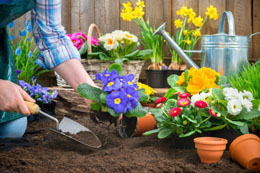Intensive gardening is a well planned method of gardening which minimizes wastage of land and intends to achieve maximum produce from it. This gardening is most suitable when the available land is small. The following article explains the different techniques used in this gardening form for making good use of the available land.

Intensive form of gardening is aimed at obtaining maximum sustainable yields with minimized efforts. The different aspects that have to be considered are nutrient needs, interrelationships of different crops, growing seasons, growth patterns, and shade tolerance.
The Basics
This form of gardening utilizes resources to the maximum extent. The methods presented in the paragraphs below will help in carrying out backyard gardening effectively.
Raised Bed
This form of gardening can be carried out in the best possible way with the use of raised beds. These beds are 3-4 feet wide and vary in length. The small size of beds makes it easy to prepare the soil. Vegetable growth in the spring season is benefited with this practice because the warming of these beds takes place quickly.
Spacing
Close spacing is one of the characteristics of raised beds. Staggered rows are recommended for the intensive form of gardening.
Inter cropping
Rows of slow-growing species are planted along with those which grow quickly. For example, plants like peas, broccoli, cabbage, and tomatoes are planted with quick-growing radishes and onions.
Succession Planting
This method allows harvesting of plants one-by-one, in succession. In this technique, the same crop is planted in separate batches with a gap of 1-2 weeks. By the time the first patch is raked and the crop is harvested, plants in the second one start reaching maturity. The first patch should be planted immediately with the next crop so that the cycle continues perpetually.
Relay Planting
In this form of planting, a new crop is planted in the same space where another plant is already growing but about to reach maturity. By the time the earlier crop gets harvested, the new crop is established properly in the soil.
The French Method
The biointensive or French intensive gardening method is an organic form of gardening/agriculture. It is a form of small plot gardening which uses techniques like double digging raised beds and companion planting.
Double Digging Raised Beds
These beds are prepared by tilling the soil of the given patch in a width-wise pattern. The first trench should be dug to a depth of 12 inches. The soil from this trench should to be further loosened (12 inches); thus, in total, soil is tilled up to the depth of 24 inches. Soil removed from the latter trench is filled in the first one. Again, the soil in the second trench is loosened up to 24 inches. This pattern continues till the last trench which is then filled with soil dug up from the first one. The significance of carrying out this method is that soil is tilled below the normal level and helps in the growth of roots, as well as keeps them aerated.
Companion Planting
This method makes use of the vertical space efficiently by recognizing the needs of the plants. For example, deep-rooted plants can be grown with those having shallow roots. The vertical space from which these plants absorb nutrients is different, and therefore, they co-exist without conflicting with each others' interests.
Calorie Farming
In this farming, minimum area is utilized for growing plants with high calorie content. Root crops like potatoes, leek, garlic, parsnips, burdocks, etc. are suited for calorie farming. More nutrients can be obtained from smaller areas with the practice of this method.






 Intensive form of gardening is aimed at obtaining maximum sustainable yields with minimized efforts. The different aspects that have to be considered are nutrient needs, interrelationships of different crops, growing seasons, growth patterns, and shade tolerance.
Intensive form of gardening is aimed at obtaining maximum sustainable yields with minimized efforts. The different aspects that have to be considered are nutrient needs, interrelationships of different crops, growing seasons, growth patterns, and shade tolerance.